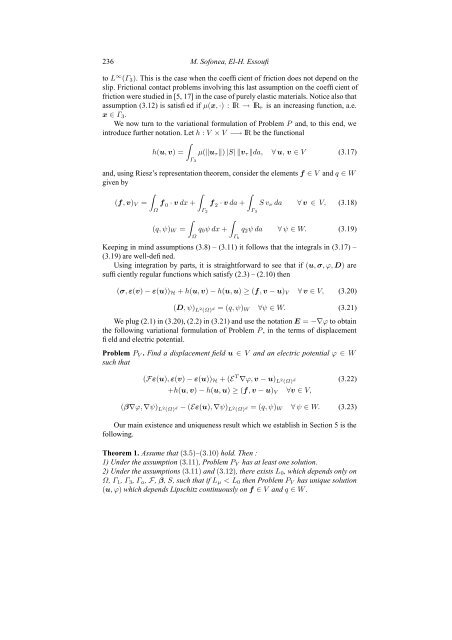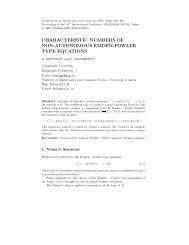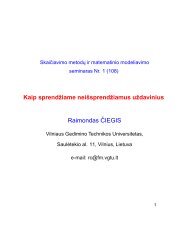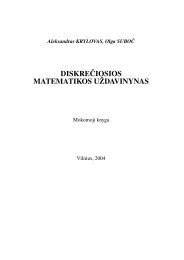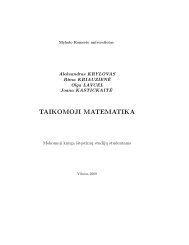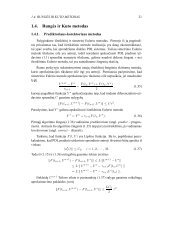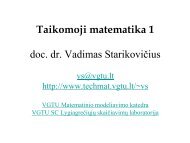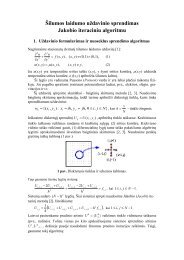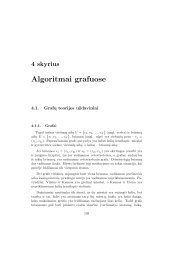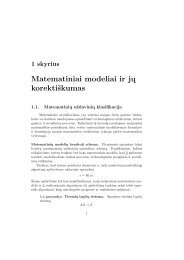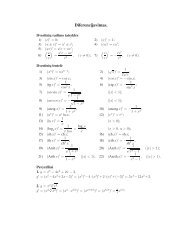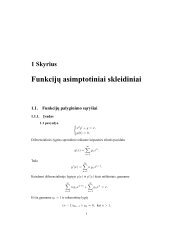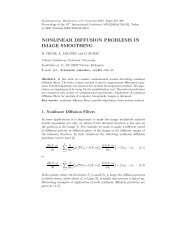a piezoelectric contact problem with slip dependent coefficient of ...
a piezoelectric contact problem with slip dependent coefficient of ...
a piezoelectric contact problem with slip dependent coefficient of ...
You also want an ePaper? Increase the reach of your titles
YUMPU automatically turns print PDFs into web optimized ePapers that Google loves.
236 M. S<strong>of</strong>onea, El-H. Essoufito L ∞ (Γ 3 ). This is the case when the <strong>coefficient</strong> <strong>of</strong> friction does not depend on the<strong>slip</strong>. Frictional <strong>contact</strong> <strong>problem</strong>s involving this last assumption on the <strong>coefficient</strong> <strong>of</strong>friction were studied in [5, 17] in the case <strong>of</strong> purely elastic materials. Notice also thatassumption (3.12) is satisfied if µ(x, ·) : IR → IR + is an increasing function, a.e.x ∈ Γ 3 .We now turn to the variational formulation <strong>of</strong> Problem P and, to this end, weintroduce further notation. Let h : V × V −→ IR be the functional∫h(u, v) = µ(‖u τ ‖) |S| ‖v τ ‖da, ∀ u, v ∈ V (3.17)Γ 3and, using Riesz’s representation theorem, consider the elements f ∈ V and q ∈ Wgiven by∫∫∫(f, v) V = f 0 · v dx +Ωf 2 · v da +Γ 2S v ν daΓ 3∀ v ∈ V, (3.18)∫ ∫(q, ψ) W = q 0 ψ dx + q 2 ψ daΓ b∀ ψ ∈ W. (3.19)ΩKeeping in mind assumptions (3.8) – (3.11) it follows that the integrals in (3.17) –(3.19) are well-defined.Using integration by parts, it is straightforward to see that if (u, σ, ϕ, D) aresufficiently regular functions which satisfy (2.3) – (2.10) then(σ, ε(v) − ε(u)) H + h(u, v) − h(u, u) ≥ (f, v − u) V ∀ v ∈ V, (3.20)(D, ψ) L 2 (Ω) d = (q, ψ) W ∀ψ ∈ W. (3.21)We plug (2.1) in (3.20), (2.2) in (3.21) and use the notation E = −∇ϕ to obtainthe following variational formulation <strong>of</strong> Problem P , in the terms <strong>of</strong> displacementfield and electric potential.Problem P V . Find a displacement field u ∈ V and an electric potential ϕ ∈ Wsuch that(Fε(u), ε(v) − ε(u)) H + (E T ∇ϕ, v − u) L 2 (Ω) d (3.22)+h(u, v) − h(u, u) ≥ (f, v − u) V ∀v ∈ V,(β∇ϕ, ∇ψ) L2 (Ω) d − (Eε(u), ∇ψ) L 2 (Ω) d = (q, ψ) W ∀ ψ ∈ W. (3.23)Our main existence and uniqueness result which we establish in Section 5 is thefollowing.Theorem 1. Assume that (3.5)–(3.10) hold. Then :1) Under the assumption (3.11), Problem P V has at least one solution.2) Under the assumptions (3.11) and (3.12), there exists L 0 , which depends only onΩ, Γ 1 , Γ 3 , Γ a , F, β, S, such that if L µ < L 0 then Problem P V has unique solution(u, ϕ) which depends Lipschitz continuously on f ∈ V and q ∈ W .


